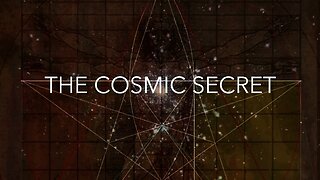Premium Only Content

In Search Of Ancient Astronauts
In Search Of Ancient Astronauts!
One of the early In Search Of... specials produced in the seventies by Alan Landsburg, featuring narration by Rod Serling. Classic TV! About: To paraphrase Dr. Joseph Campbell on the subject: "The god weeps tears which is the rain and therefore fertilizes the soil bringing forth life; but they're also tears of compassion because out of life also comes sorrow and hardship". The following is an excerpt taken from the World Almanac the book of The Strange: Tiahuanco as a pre-Columbian ruin located in Bolivia whose origins are unknown. The most remarkable feature of the palace is the gateway to the Sun, a monolithic gateway cut from one piece of andesite, a very hard rock that stands 11 ft high and almost 15 ft wide. The upper portion of one side is covered with a frieze carved bas relief. At the center of the frieze is a sun god, presumably the principal Tiahuanco deity, with sun rays radiating from his face in the form of puma heads. He holds two staffs adorned with puma and condor heads, and he is weeping tears shaped like condors and pumas. The Sun God is flanked on each side by 24 figures all facing him and seemingly running toward him. The opposite side of the portal is covered with a severe geometrical pattern. According to A. Hyatt Verrill, various parts of the design are so mathematically exact that even using a steel square and millimeter scale, he could not find a deviation of more than 1/50th of an inch in the angles or surfaces. It is generally accepted that the construction of Tiahuanco took place during several periods. The earliest construction, dating from 200 BC to 200 AD, shows a stylistic similarity to the Pucara culture centered in Southern Peru dating from the same period Many of the major buildings are believed to date from ad 200 to 600. Constructions continued from 600 to 1000 during which time the spread of Pucara culture was seen in other areas in Central southern Andes.
As the motif of the gate's weeping God spread throughout Peru, the tears change from condors and pumas to snakes and human heads. (The article goes on to talk about how religious leaders influencing men would get them to do great things such as moving and cutting these stones). The Andes abound with varieties of stones harder than andesite, and there are strong indications that the pre-inca Indians had discovered bronze. Finally, the position of the design is not beyond the simplest geometry and the ritual care that would be devoted to the god's Gateway over a period of decades. Verrill goes on to suggest these men had also discovered the wheel. The simplest explanation for the transportation of these stones is that large numbers of men used their own brute strength to pull, push, slide, or roll the massive stones from the quarry to the present site. Again, devotion to the God and to his King combined with the organization and sense of purpose which great leaders bring to their people is sufficient to explain the motivation. The article also cites Charles Berlitz, Jaques Bergier, and GS Hawkins who have done research and articles.
-
 2:09:03
2:09:03
Documentaries
12 days agoThe Cosmic Secret-Featuring David Wilcock
1831 -
 LIVE
LIVE
Viss
5 hours ago🔴LIVE - Completing Quests & Annihilating All in Our Path! - Arc Raiders!
120 watching -
 53:51
53:51
The Rubin Report
3 hours agoBill Maher Obliterates Patton Oswalt’s Liberal Bubble in Only 2 Minutes
37.5K44 -
 LIVE
LIVE
LumpyPotatoX2
3 hours agoWhere Winds Meet: Just Petting Kitties - Made in China
64 watching -
 LIVE
LIVE
ReAnimateHer
19 hours ago $0.12 earnedTwisted Tales & True Crime - Inbred Byrd Sisters & Graysone Homestead
73 watching -
 1:08:01
1:08:01
iCkEdMeL
2 hours ago $1.06 earned🚨Mom Gives Birth on Highway After Kicked Out of Hospital?!
17.3K4 -
 14:28
14:28
Clownfish TV
5 hours agoDisney is DONE with DEI?! | Clownfish TV
9.17K9 -
 LIVE
LIVE
LFA TV
16 hours agoLIVE & BREAKING NEWS! | TUESDAY 11/18/25
2,353 watching -
 DVR
DVR
The Shannon Joy Show
3 hours agoLicense To Kill - The PREP Act, BARDA & How The US Government Legalized Democide. LIVE With Sasha Latypova
11.8K4 -
 32:16
32:16
Grant Stinchfield
2 hours ago $1.23 earnedAI Sam Altman’s Baby Lab: Silicon Valley Tries to Play God!
9.72K2